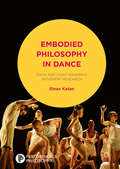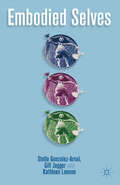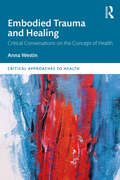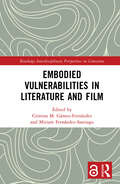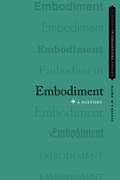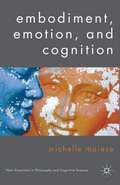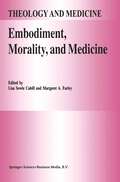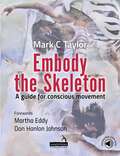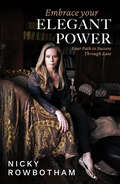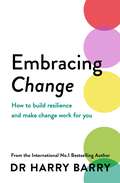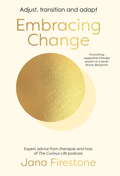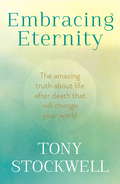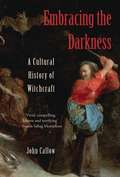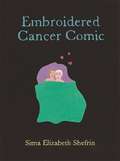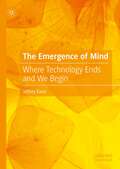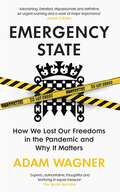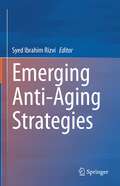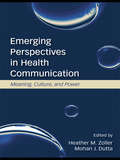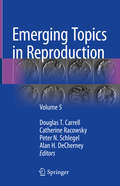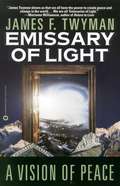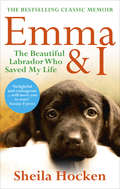- Table View
- List View
Embodied Philosophy in Dance: Gaga and Ohad Naharin's Movement Research (Performance Philosophy)
by Einav Katan-SchmidRepresenting the first comprehensive analysis of Gaga and Ohad Naharin's aesthetic approach, this book follows the sensual and mental emphases of the movement research practiced by dancers of the Batsheva Dance Company. Considering the body as a means of expression, Embodied Philosophy in Dance deciphers forms of meaning in dance as a medium for perception and realization within the body. In doing so, the book addresses embodied philosophies of mind, hermeneutics, pragmatism, and social theories in order to illuminate the perceptual experience of dancing. It also reveals the interconnections between physical and mental processes of reasoning and explores the nature of physical intelligence.
Embodied Selves
by Stella Gonzalez-Arnal, Gill Jagger and Kathleen LennonThis interdisciplinary collection explores the role the body plays in constituting our sense of self, signalling the interplay between material embodiment, social meaning, and material and social conditions.
Embodied Trauma and Healing: Critical Conversations on the Concept of Health (Critical Approaches to Health)
by Anna WestinWhat if philosophy could solve the psychological puzzle of trauma? Embodied Trauma and Healing argues just that, suggesting that one might be needed in order to understand the other. The book demonstrates how the body-mind problem that haunted Descartes was addressed by phenomenologists, whilst also proposing that the human experience is lived subjectively as embodied consciousness. Throughout this book, the author suggests that the phenomenological tools that are used to explore the body can also be an effective way to discuss the physical and mental aspects of embodied trauma. Drawing on the work of Paul Ricœur, Maurice Merleau-Ponty and Emmanuel Lévinas, the book outlines a phenomenological approach to the embodied and relational subject. It offers a reading of embodied trauma that can connect it to wider conversations in psychological underpinnings of trauma through Peter Levine’s somatic research and Bessel van der Kolk’s embodied remembering. Connecting to the analytic tradition, the book suggests that phenomenology can unify both language-based and body-based therapeutic practice. It also presents a compelling discussion that ties the embodied experience of relation in trauma to the wider causal factors of social suffering and relational rupture, intergenerational trauma and the trauma of land, as informed by phenomenology. Embodied Trauma and Healing is essential reading for researchers within the fields of philosophy, psychology and medical humanities for it actively engages with contemporary configurations of trauma theory and recent research developments in healing and mental disorder diagnosis.
Embodied Trauma and Healing: Critical Conversations on the Concept of Health (Critical Approaches to Health)
by Anna WestinWhat if philosophy could solve the psychological puzzle of trauma? Embodied Trauma and Healing argues just that, suggesting that one might be needed in order to understand the other. The book demonstrates how the body-mind problem that haunted Descartes was addressed by phenomenologists, whilst also proposing that the human experience is lived subjectively as embodied consciousness. Throughout this book, the author suggests that the phenomenological tools that are used to explore the body can also be an effective way to discuss the physical and mental aspects of embodied trauma. Drawing on the work of Paul Ricœur, Maurice Merleau-Ponty and Emmanuel Lévinas, the book outlines a phenomenological approach to the embodied and relational subject. It offers a reading of embodied trauma that can connect it to wider conversations in psychological underpinnings of trauma through Peter Levine’s somatic research and Bessel van der Kolk’s embodied remembering. Connecting to the analytic tradition, the book suggests that phenomenology can unify both language-based and body-based therapeutic practice. It also presents a compelling discussion that ties the embodied experience of relation in trauma to the wider causal factors of social suffering and relational rupture, intergenerational trauma and the trauma of land, as informed by phenomenology. Embodied Trauma and Healing is essential reading for researchers within the fields of philosophy, psychology and medical humanities for it actively engages with contemporary configurations of trauma theory and recent research developments in healing and mental disorder diagnosis.
Embodied VulnerAbilities in Literature and Film (Routledge Interdisciplinary Perspectives on Literature)
by Gámez-Fernández, Cristina M Miriam Fernández-SantiagoEmbodied VulnerAbilities in Literature and Film includes a collection of essays exploring the ways in which recent literary and filmic representations of vulnerability depict embodied forms of vulnerability across languages, media, genres, countries, and traditions in the late 20th and early 21st centuries. The volume gathers 12 chapters penned by scholars from Japan, the USA, Canada, and Spain which look into the representation of vulnerability in human bodies and subjectivities. Not only is the array of genres covered in this volume significant— from narrative, drama, poetry, (auto)documentary, or film— in fiction and nonfiction, but also the varied cultural and linguistic coordinates of the literary and filmic texts scrutinized—from the USA, Canada, Spain, France, the Middle East, to Japan. Readers who decide to open the cover of this volume will benefit from becoming familiar with a relatively old topic— that of vulnerability— from a new perspective, so that they can consider the great potential of this critical concept anew.
Embodied VulnerAbilities in Literature and Film (Routledge Interdisciplinary Perspectives on Literature)
Embodied VulnerAbilities in Literature and Film includes a collection of essays exploring the ways in which recent literary and filmic representations of vulnerability depict embodied forms of vulnerability across languages, media, genres, countries, and traditions in the late 20th and early 21st centuries. The volume gathers 12 chapters penned by scholars from Japan, the USA, Canada, and Spain which look into the representation of vulnerability in human bodies and subjectivities. Not only is the array of genres covered in this volume significant— from narrative, drama, poetry, (auto)documentary, or film— in fiction and nonfiction, but also the varied cultural and linguistic coordinates of the literary and filmic texts scrutinized—from the USA, Canada, Spain, France, the Middle East, to Japan. Readers who decide to open the cover of this volume will benefit from becoming familiar with a relatively old topic— that of vulnerability— from a new perspective, so that they can consider the great potential of this critical concept anew.
Embodiment: A History (Oxford Philosophical Concepts)
by Justin E. H. SmithEmbodiment--defined as having, being in, or being associated with a body--is a feature of the existence of many entities, perhaps even of all entities. Why entities should find themselves in this condition is the central concern of the present volume. The problem includes, but also goes beyond, the philosophical problem of body: that is, what the essence of a body is, and how, if at all, it differs from matter. On some understandings there may exist bodies, such as stones or asteroids, that are not the bodies of any particular subjects. To speak of embodiment by contrast is always to speak of a subject that variously inhabits, or captains, or is coextensive with, or even is imprisoned within, a body. The subject may in the end be identical to, or an emergent product of, the body. That is, a materialist account of embodied subjects may be the correct one. But insofar as there is a philosophical problem of embodiment, the identity of the embodied subject with the body stands in need of an argument and cannot simply be assumed. The reasons, nature, and consequences of the embodiment of subjects as conceived in the long history of philosophy in Europe as well as in the broader Mediterranean region and in South and East Asia, with forays into religion, art, medicine, and other domains of culture, form the focus of these essays. More precisely, the contributors to this volume shine light on a number of questions that have driven reflection on embodiment throughout the history of philosophy. What is the historical and conceptual relationship between the idea of embodiment and the idea of subjecthood? Am I who I am principally in virtue of the fact that I have the body I have? Relatedly, what is the relationship of embodiment to being and to individuality? Is embodiment a necessary condition of being? Of being an individual? What are the theological dimensions of embodiment? To what extent has the concept of embodiment been deployed in the history of philosophy to contrast the created world with the state of existence enjoyed by God? What are the normative dimensions of theories of embodiment? To what extent is the problem of embodiment a distinctly western preoccupation? Is it the result of a particular local and contingent history, or does it impose itself as a universal problem, wherever and whenever human beings begin to reflect on the conditions of their existence? Ultimately, to what extent can natural science help us to resolve philosophical questions about embodiment, many of which are vastly older than the particular scientific research programs we now believe to hold the greatest promise for revealing to us the bodily basis, or the ultimate physical causes, of who we really are?
Embodiment, Emotion, and Cognition (New Directions in Philosophy and Cognitive Science)
by Michelle MaieseBeginning with the view that human consciousness is essentially embodied and that the way we consciously experience the world is structured by our bodily dynamics and surroundings, the book argues that emotions are a fundamental manifestation of our embodiment, and play a crucial role in self-consciousness, moral evaluation, and social cognition.
Embodiment, Morality, and Medicine (Theology and Medicine #6)
by Margaret A. Farley Lisa SowleCahillEmbodiment, Morality and Medicine deals with the relevance of `embodiment' to bioethics, considering both the historical development and contemporary perspectives on the mind--body relation. The emphasis of all authors is on the importance of the body in defining personal identity as well as on the role of social context in shaping experience of the body. Among the perspectives considered are Christian, Jewish, Islamic, Buddhist, and African-American. Feminist concerns are important throughout.
EMBODIMENT OPC C: A History (Oxford Philosophical Concepts)
by Justin E. H. SmithEmbodiment--defined as having, being in, or being associated with a body--is a feature of the existence of many entities, perhaps even of all entities. Why entities should find themselves in this condition is the central concern of the present volume. The problem includes, but also goes beyond, the philosophical problem of body: that is, what the essence of a body is, and how, if at all, it differs from matter. On some understandings there may exist bodies, such as stones or asteroids, that are not the bodies of any particular subjects. To speak of embodiment by contrast is always to speak of a subject that variously inhabits, or captains, or is coextensive with, or even is imprisoned within, a body. The subject may in the end be identical to, or an emergent product of, the body. That is, a materialist account of embodied subjects may be the correct one. But insofar as there is a philosophical problem of embodiment, the identity of the embodied subject with the body stands in need of an argument and cannot simply be assumed. The reasons, nature, and consequences of the embodiment of subjects as conceived in the long history of philosophy in Europe as well as in the broader Mediterranean region and in South and East Asia, with forays into religion, art, medicine, and other domains of culture, form the focus of these essays. More precisely, the contributors to this volume shine light on a number of questions that have driven reflection on embodiment throughout the history of philosophy. What is the historical and conceptual relationship between the idea of embodiment and the idea of subjecthood? Am I who I am principally in virtue of the fact that I have the body I have? Relatedly, what is the relationship of embodiment to being and to individuality? Is embodiment a necessary condition of being? Of being an individual? What are the theological dimensions of embodiment? To what extent has the concept of embodiment been deployed in the history of philosophy to contrast the created world with the state of existence enjoyed by God? What are the normative dimensions of theories of embodiment? To what extent is the problem of embodiment a distinctly western preoccupation? Is it the result of a particular local and contingent history, or does it impose itself as a universal problem, wherever and whenever human beings begin to reflect on the conditions of their existence? Ultimately, to what extent can natural science help us to resolve philosophical questions about embodiment, many of which are vastly older than the particular scientific research programs we now believe to hold the greatest promise for revealing to us the bodily basis, or the ultimate physical causes, of who we really are?
Embody the Skeleton: A guide for conscious movement
by Mark TaylorSomatic Movement Education allows efficient movement patterns to replace inefficient ones, resulting in ease of movement, more functional postural alignment, and the creation of space for the healing response of cellular and tissue reorganization. This book provides clear experiential guidance for embodiment of the skeletal system, through movement facilitation, hands-on facilitation, and movement meditations, supported by essential anatomical information and illustrations. Intended as a guide for movement practitioners, educators, and therapists in many disciplines and by anyone interested in mindful movement, the book addresses the healthy embodiment of each bone and joint in the body as well as techniques for bringing awareness to the skeletal system as a whole. The book is accompanied by a series of recorded movement meditations guided by the author.
Embrace Your Elegant Power: Your Path to Success Through Ease
by Nicky RowbothamCarve a path to success through ease.One that lights you up with a sense of soul, flow and grace. When we embrace the elegant power in our own lives, we step into our ‘inner knowing’ and fully own our innate, intuitive and individual gifts. When we unshackle from the shoulds of societal conditioning around how we are expected to show up in our lives we redefine success on our own terms, as we own what makes us different, special and unique.But how do we do this?By stepping into our own natural light.It’s not about changing or becoming. It’s about remembering and knowing that we are already enough. Our authentic nature glows from within at a soul level. It emanates from every pore with our knowing that we have elegant power in our enoughness.This is the path to easefulness in our lives, success through ease. When we are grounded in a sense of self-worth and self-love we do not seek approval or validation from outside of ourselves. We need to live more deliberately and authentically, owning our own path in a way that celebrates, accepts and embraces our own innate power with an elegant soul, flow and grace.Nicky Rowbotham’s Embrace Your Elegant Power will help you move from playing small to shining bright in your own life, in a way that works for you. It will shift your perspectives and create a sense of spaciousness and thoughtful simplicity within your life for a more aligned, authentic individual energy to come through.Full of powerful, personal and transformative stories and insights, Embrace Your Elegant Power is your level-up guide to celebrating your own uniqueness and using easefulness as the frequency holder for your life.Nicky Rowbotham is the founder of Inspired Change and the author of the best-seller 7 Steps to Finding Flow: Flip the Script on Stress. An intuitive health coach, speaker and thought leader, Nicky is committed to helping people carve a new, more easeful path to success.
Embracing Change: How to build resilience and make change work for you
by Dr Harry BarryThis year has demonstrated how quickly our lives can change completely without warning. But every day we face change - whether it's small changes such as an unscheduled meeting or plans going awry, to bigger changes such as a change of job or coping with the loss of a loved one. Our lives are constantly moving and we, in turn, must move with them. In his latest book, bestselling author Dr Harry Barry shows us how to not only cope with change but learn in the process, and therefore grow and develop as a human being. Dr Barry, with the benefit of over thirty-five-years-experience as a family doctor assisting people in crisis, shares the practical tools and techniques required to manage change effectively and live your life to the fullest. Revealing how to become the ultimate pragmatist - accepting that there is no such thing as the perfect solution, just the best solution one can find at that moment in time. Embracing Change is a practical, compassionate companion for anyone looking to boost their resilience, adapt to life's challenges, and by smoothly navigating through them, reach calmer waters.
Embracing Eternity
by Tony StockwellTop TV psychic Tony Stockwell brings us more incredible stories of life after death, as well as inspirational advice on how to channel the power of the spirit realm.Tony's work brings him into contact with people from all over the world who look to him for insight into the continuing existence of their departed loved ones. His awesome abilities to connect with the spirits are truly inspirational and in Embracing Eternity, the follow up to his hugely successful memoir Spirited, he shares those stories of connection and comfort. There are also fascinating case studies showcasing Tony's techniques and advice on how we can all embrace our latent powers to explore the spirit realms. Moving and awe-inspiring, this is a fascinating glimpse of the world beyond the grave.
Embracing the Darkness: A Cultural History of Witchcraft
by John CallowAs dusk fell on a misty evening in 1521, Martin Luther - hiding from his enemies at Wartburg Castle - found himself seemingly tormented by demons hurling walnuts at his bedroom window. In a fit of rage, the great reformer threw at the Devil the inkwell from which he was preparing his colossal translation of the Bible.
Embroidered Cancer Comic (PDF)
by Sima Elizabeth Shefrin'Come to bed with me?' 'Huh? No, I'd rather read this book about cancer...' As soon as Bob was diagnosed with aggressive prostate cancer, he and his wife Elizabeth started making cancer jokes to take the edge off of an otherwise frightening situation. A lot of those jokes were about sex. Here, textile artist Elizabeth Shefrin has picked up a needle and thread to share those intimate jokes, revealing how they helped her and her husband to process the realities of cancer treatment. Giving lightness and humour to a rarely discussed topic, this unpretentious and wry embroidered comic will create awareness and discourse around a taboo topic, resonating with others in similar situations and reassuring us that it's ok to laugh.
The Emergence of Mind: Where Technology Ends and We Begin
by Jeffrey KaneWhile it may appear that generative AI has mastered the mystery of the human mind and released its full power, The Emergence of Mind: Where Technology Ends and We Begin demonstrates the profound and fundamental limitations of the technology and its use as a model of human thinking. In response, the book offers an emergent model of the human mind rooted in our experiences as living, sentient, social and conscious beings. The text explores the nature of meaning in human cognition and the critical importance of the experience of ideas. In so doing, it offers insights into the cultivation of specific generative capacities of the human mind.
Emergency State: How We Lost Our Freedoms in the Pandemic and Why it Matters
by Adam Wagner'Superb... authoritative, thoughtful and terrifying in equal measure', The Secret Barrister'Astonishing. Detailed, dispassionate and definitive. An urgent warning and work of major importance', James O'Brien0n 26 March 2020, a new law appeared. In eleven pages it locked down tens of millions of people, confined us to our homes, banned socialising, closed shops, gyms, pubs, places of worship. It restricted our freedoms more than any other law in history, justified by the rapid spread of a deadly new virus.You may have expected such a law to be fiercely debated in Parliament. But it wasn't debated at all. A state of emergency was declared, meaning the law came into force the moment it was signed. The emergency was supposed to be short but lasted for 763 days, allowing ministers to bring in, by decree over 100 new laws restricting freedoms more than any in history - laws that were almost never debated, changed at a whim and increasingly confused the public. Meanwhile, behind the doors of Downing Street, officials and even the Prime Minister broke the very laws they had created.This book tells the startling story of the state of emergency that brought about an Emergency State. A wake-up call from one of the UK's leading human rights barristers, Emergency State shows us why we must never take our rights for granted.'A riveting account of how our democracy was put under threat during the Pandemic and why we must never let the Emergency State - all-powerful but ignorant and corrupt - take over again', Lady Hale, former President of the UK Supreme Court'Clear-eyed, forensic and compelling, Wagner sets out what happened during the Covid-19 pandemic - and the lessons we need to learn', Jonathan Freedland, author of The Escape Artist
Emerging Perspectives in Health Communication: Meaning, Culture, and Power
by Heather Zoller Mohan J. DuttaThis volume provides the theoretical, methodological, and praxis-driven issues in research on interpretive, critical, and cultural approaches to health communication. It includes an international collection of contributors, and highlights non-traditional (non-Western) perspectives on health communication.
Emerging Perspectives in Health Communication: Meaning, Culture, and Power (Leas Communication Ser.)
by Heather Zoller Mohan J. DuttaThis volume provides the theoretical, methodological, and praxis-driven issues in research on interpretive, critical, and cultural approaches to health communication. It includes an international collection of contributors, and highlights non-traditional (non-Western) perspectives on health communication.
Emerging Topics in Reproduction: Volume 5
by Douglas T. Carrell Catherine Racowsky Peter N. Schlegel Alan H. DeCherneyPreviously known as Biennial Review of Infertility, the fifth installment in this series brings together the most current research and clinical evidence on male and female infertility, emerging assisted reproductive technologies (ART) and evolving controversies in reproductive medicine. In this latest volume, parts one and two discuss recent developments in male and female infertility respectively, including fertility preservation in the male adolescent cancer patient, the clinical relevance of sperm RNA, the management of subclinical hypothyroidism, and the effects of endocrine-disrupting chemicals. Part three covers the latest in ART, such as evidence-based morphological approaches for embryo selection and culturing human embryos. The final section highlights controversies in reproductive medicine, including the use of preimplantation genetic screening (PGS) and blastocyst transfer, as well as the ethics surrounding a maximum BMI for IVF. Providing an ongoing appraisal of current knowledge, and featuring contributions from leading experts in the field, Emerging Topics in Reproduction, Volume 5 is a worthy addition to the series and an ideal resource on the latest topics for reproductive medicine and REI specialists, OB-GYNS, andrologists, and any clinician working with infertility.
Emissary of Light: A Vision of Peace
by James F. TwymanShares adventures in Bosnia & Croatia & explains how we could be on the brink of lasting world peace.
Emma and I: The Beautiful Labrador Who Saved My Life
by Sheila HockenAs a girl, Sheila never let her gradual descent into blindness prevent her from trying to do everything a sighted person could do. Then at 17, unable to see to find her way around the house she grew up in, she found herself dreading her future in an 'ever darkening vacuum'.But then the remarkable Emma enters her life, and Sheila begins a journey that brings her the independence, love and happiness she never dreamed possible.Emma and I is the moving and inspirational story of the unique bond between Sheila and her dog, and shows that, sometimes, miracles do happen.
